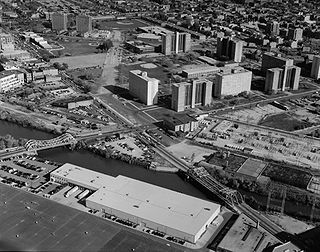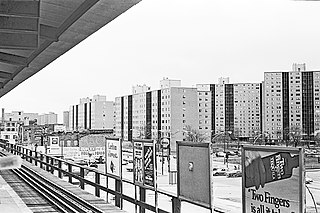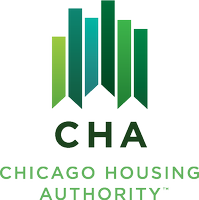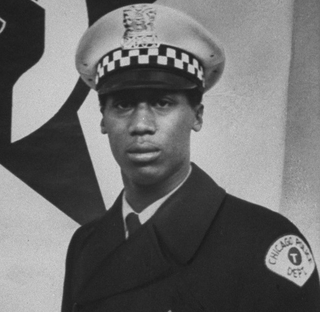
Cabrini–Green Homes was a Chicago Housing Authority (CHA) public housing project on the Near North Side of Chicago, Illinois. The Frances Cabrini Rowhouses and Extensions were south of Division Street, bordered by Larrabee Street to the west, Orleans Street to the east and Chicago Avenue to the south, with the William Green Homes to the northwest.

Robert Taylor Homes was a public housing project in the Bronzeville neighborhood on the South Side of Chicago, Illinois from 1962 to 2007. The largest housing project in the United States, it consisted of 28 virtually identical high-rises, set out in a linear plan for two miles, with the high-rises regularly configured in a horseshoe shape of three in each block. It was located along State Street between Pershing Road and 54th Street, east of the Dan Ryan Expressway. The project was named for Robert Rochon Taylor (1899–1957), an African-American activist and the first African American chairman of the Chicago Housing Authority (CHA). It was a part of the State Street Corridor which included other CHA housing projects: Stateway Gardens, Dearborn Homes, Harold Ickes Homes, and Hilliard Homes.

The Chicago Police Department (CPD) is the primary law enforcement agency of the city of Chicago, Illinois, United States, under the jurisdiction of the Chicago City Council. It is the second-largest municipal police department in the United States, behind the New York City Police Department. As of 2022 CPD had 11,710 sworn officers on duty, and in 2020 had over 948 other employees. Tracing its roots to 1835, the Chicago Police Department is one of the oldest modern police departments in the world.

The San Francisco Police Department (SFPD) is the municipal law enforcement agency of the City and County of San Francisco, as well as the San Francisco International Airport in San Mateo County. In 2000, the SFPD was the 11th largest police department in the United States.

Stateway Gardens was a Chicago Housing Authority (CHA) public housing project located in the Bronzeville neighborhood on the South Side of Chicago, Illinois.

The Columbus Division of Police (CPD) is the primary law enforcement agency for the city of Columbus, Ohio, in the United States. It is the largest police department in Ohio, and among the twenty-five largest in the United States. It is composed of twenty precincts and numerous other investigative and support units. Chief Elaine Bryant assumed leadership of the Division in 2021. Special units of the Columbus Division of Police include a Helicopter Unit, Canine Unit, Mounted Unit, Community Response Teams, Marine Park Unit, and Special Weapons and Tactics Team (SWAT).
Chicago Alternative Policing Strategy (CAPS) is a community driven policing strategy designed for the Chicago Police Department that aims to bridge the gap between the police force and the citizens of Chicago. CAPS started in 1993 as a pilot program in five of the 25 police districts in Chicago - Englewood, Marquette, Austin, Morgan Park, and Rogers Park - after a realization that the community and police were becoming increasingly isolated from one another throughout Chicago since the early 1960s. The original five districts, characterized by high crime rates and cases of extreme poverty, provided the Chicago Police Department with an initial benchmark from which to determine the program's strengths and weaknesses. By 1995, the Chicago Police Department implemented CAPS across all Chicago neighborhoods with the goal of blending traditional policing strategies with alternative strategies aimed at encouraging community members and police to work together in order to prevent and control crime. The program's motto, "Together We Can," emphasizes the need for increased lines of communication between the community and the police, so that together they could come up with solutions for chronic neighborhood problems.

The Delta Police Department (DPD) is the police force for the City of Delta, British Columbia, a suburban community in Metro Vancouver with a population of 102,661. As of 2019, the Delta Police Department has an authorized strength of 194 sworn members and 72 civilian support staff, and an operating budget of $35,981,000.

The Chicago Housing Authority (CHA) is a municipal corporation that oversees public housing within the city of Chicago. The agency's Board of Commissioners is appointed by the city's mayor, and has a budget independent from that of the city of Chicago. CHA is the largest rental landlord in Chicago, with more than 50,000 households. CHA owns over 21,000 apartments. It also oversees the administration of 37,000 Section 8 vouchers. The current acting CEO of the Chicago Housing Authority is Tracey Scott.

The Virginia Tech Police Department (VTPD) is a nationally accredited police department with jurisdiction over Virginia Polytechnic Institute and State University. The departments original accreditation with CALEA was awarded on November 18, 1995 and the department has continued with re-accreditation. In November 2015, the department met "gold standard" and also won CALEA's "Accreditation with Excellence" award.
Crime in Chicago has been tracked by the Chicago Police Department's Bureau of Records since the beginning of the 20th century. The city's overall crime rate, especially the violent crime rate, is higher than the US average. Gangs in Chicago have a role in the city's crime rate. The number of homicides in Chicago hit a 25-year high in 2021.

The Minneapolis Police Department (MPD) is the primary law enforcement agency in Minneapolis, Minnesota, United States. It is also the largest police department in Minnesota. Formed in 1867, it is the second-oldest police department in Minnesota, after the Saint Paul Police Department that formed in 1854. A short-lived Board of Police Commissioners existed from 1887 to 1890.

Henry Horner Homes was a Chicago Housing Authority (CHA) public housing project located in the Near West Side community area on the West Side of Chicago, Illinois, United States. The original section of Henry Horner Homes was bordered by Oakley Boulevard to the west, Washington Boulevard to the south, Hermitage Avenue to the east, and Lake Street to the north near the United Center. A discontiguous section named Horner Annex was bordered by Honore Street to the west, Adams Street to the south, Wood Street to the east, and Monroe Street to the north. Constructed between 1957 and 1963, The housing project was named in honor of former Illinois governor Henry Horner.

The Cleveland Division of Police (CDP) is the governmental agency responsible for law enforcement in the city of Cleveland, Ohio. Karrie Howard is the Director of Public Safety and Dornat "Wayne" Drummond is Chief of Police.

Renault Alvin Robinson was an American police officer who served at the Chicago Police Department from 1964 to 1983. Robinson served as chairman of the Chicago Housing Authority under the leadership of former Chicago Mayor Harold Washington from August 1983 until January 1987. He was most known for founding the African American Patrolman's League. During his career as a police officer, Robinson was responsible for bringing a civil rights lawsuit against the Chicago Police Department for discrimination against minorities.

The New York City Police Department (NYPD) is structured into numerous bureaus and units. As a whole, the NYPD is headed by the Police Commissioner, a civilian administrator appointed by the Mayor, with the senior sworn uniformed officer of the service titled "Chief of Department". The Police Commissioner appoints the First Deputy Commissioner as the department's second-in-command and the Chief of Department as the department's highest ranking uniformed officer. The commissioner also appoints a number of deputy and assistant commissioners who do not have operational command and are solely for support and administrative function. The department is divided into twenty bureaus, six of which are enforcement bureaus. Each enforcement bureau is further subdivided into sections, divisions, and units, and into patrol boroughs, precincts, and detective squads. Each bureau is commanded by a bureau chief. There are also a number of specialized units that are not part of any of the bureaus and report to the Chief of the Department.
The Columbia Police Department (CPD) is the principal law enforcement agency serving the city of Columbia, Missouri in the United States. It protects a metropolitan population of nearly 127,000 with 187 sworn police officers.
The Fernwood Park Race Riot was a race massacre instigated by white residents against African American residents who inhabited the Chicago Housing Authority (CHA) veterans' housing project in the Fernwood Park neighborhood in Chicago. Area residents viewed this as one of several attempts by the CHA to initiate racial integration into white communities. The riot took place between 98th and 111th streets and lasted for three days, from the day veterans and their families moved into the project, August 13th, 1947 to August 16th, 1947. The Chicago Police Department did little to stop the rioting, as was the case a year before at the Airport Homes race riots. It was one of the worst race riots in Chicago history.

Eddie T. Johnson is an American retired police officer for the Chicago Police Department. He served as the 62nd Superintendent of the Chicago Police Department from March 2016 until December 2019.

The Cocoa Police Department (CPD) is the primary law enforcement agency for the city of Cocoa, Florida, and is accredited through the state of Florida. The department services approximately 19,000 residents within 15.41 sq miles of the municipality. The department also serves roughly 2,500 daily non-residents who commute to the municipality for employment.

















